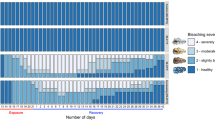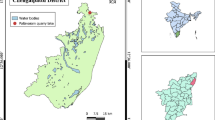Abstract
Desmarestia viridis,known to have an extremely low pH cell sap, supported rapidly increasing yeast populations in aquatic model systems. Population levels reached 108 yeasts ml-1 with an approximate doubling time of 1d. During incubation,pH declined in all systems except those receiving added carbon sources. Maximum yeast populations were not influenced by the initial experimental acidification of the medium or the presence of antibiotics added to suppress the growth of bacteria. In an unsupplemented system, Rhodotorula rubra and R. glutinis were the dominant yeasts. Systems with added organic material were dominated by a non-pigmented yeast. Examination of the algal filaments after 11 wk demonstrated little difference between experimental treatments, and that the filaments retained their original shape. Measurement of organic content in aquatic systems indicated little remaining soluble material. Similar population trends (i.e. yeast dominance and reduced bacterial populations) were observed in sand microcosms. Under these conditions, the algal filaments lost their original shape and were converted to a detritus-like substance.
Similar content being viewed by others
Literature cited
Ahearn, D. G. and S. A. Crow: Yeasts from the North Sea and Amoco Cadiz oil. Bot. Mar. 23, 125–127 (1980)
Crow, S. A., P. I. Bowman and D. G. Ahearn: Isolation of atypical Candida albicans from the North Sea. Appl. environ. Microbiol. 33, 738–739 (1977)
Fell, J. W., D. G. Ahearn, S. P. Meyers and F. J. Roth: Isolation of yeasts from Biscayne Bay, Florida and adjacent benthic areas. Limnol. Oceanogr. 5, 366–371 (1960)
Haines, E. B. and R. B. Hanson: Experimental degradation of detritus made from the salt marsh plants Spartina alterniflora Loisel., Salicornia virginica L., and Juncus roemerianus Scheele. J. exp. mar. Biol. Ecol. 40, 27–40 (1979)
Hanson, R. B., K. R. Tenore, S. Bishop, C. F. Chamberlain, M. M. Pamatmat and J. H. Tietjen: Benthic enrichment in the Georgia Bight related to Gulf Stream intrusions and estuarine outwelling. J. mar. Res. 39, 417–441 (1981)
Hobbie, J. E., R. J. Daley and S. Jasper: Use of the nuclepore filter for the counting of bacteria by fluorescence microscopy. Appl. environ. Microbiol. 33, 1225–1228 (1972)
Hoppe, H.-G.:Untersuchungen zur Ökologie der Hefen im Bereich der westlichen Ostree. Kiel. Meeresforsch. 28, 54–77 (1972)
Kawakita, S. and N. van Uden: Occurrence and population densities of yeast species in the digestive tract of gulls and turns. J. gen. Microbiol. 8, 125–129 (1963)
Kesseler, H.: Zellsaftgewinnung, AFS (apparent free space) und Vakuolenkonzentration der osmotisch wichtigsten mineralischen Bestandteile einiger Helgoländer Meeresalgen. Helgol. wiss. Meeresunters. 11, 258–269 (1964)
Koop K., R. A. Carter and R. C. Newell: Mannitol-fermenting bacteria as evidence for export from kelp beds. Limnol. Oceanogr. 27, 950–954 (1982)
Kriss, A. E. and M. I. Novozhilova: Are yeast organisms inhabitants of the seas and oceans? Mikrobiologiya 23, 669–683 (1954)
Lachance, M. A., M. Miranda, M. W. Miller and H. J. Phaff: Dehiscence and active spore release in pathogenic strains of the yeast Metschnikowia bicuspidata var australis: Possible predatory implications. Can. J. Microbiol 22, 1756–1761 (1976)
Lodder, J.: The yeasts a taxonomic study. 2nd ed. 1385 pp. Amsterdam: North Holland Publ. 1970
Lucas, M. I.,R. C. Newell and B. Velimirov: Heterotrophic utilization of mucilage released during fragmentation of kelp (Ecklonia maxima and Laminaria pallida) II. Differential utilisation of dissolved organic components from kelp mucilage. Mar. Ecol. Prog. Ser 4, 43–55 (1981)
Meusse, B. J. D.: Free sulfuric acid in the brown alga Desmarestia. Biochim. biophys. Acta 19, 372–374 (1956)
Meyers, S. P., D. G. Ahearn, W. Gunkel and F. J. Roth Jr.: Yeast from the North Sea. Mar. Biol. 1, 118–123 (1967a)
Meyers, S. P., D. G. Ahearn and F. J. Roth: Mycological investigations of the Black Sea. Bull. mar. Sci. 17, 576–596 (1967b)
Newell, R. C., J. G. Field and C. L. Griffiths: Energy balance and significance ofmicroorganisms in a kelp bed community. Mar. Ecol. Prog. Ser. 8, 103–113 (1982)
Newell, R. C. and M. I. Lucas: The quantitative significance of dissolved and particulate organic matter released during fragmentation of kelp in coastal waters. Kiel. Meeresforsch., Sonderh. 5, 356–369 (1981)
Noüy, du L.: An apparatus for measuring surface tension. J. gen. Physiol. 1, 521–528 (1919)
Roth, F. J., D. G. Ahearn, J. W. Fell, S. P. Meyers and S.A. Meyer: Ecology and taxonomy of yeasts isolated from various marine substrates. Limnol. Oceanogr. 7, 178–185 (1962)
Seki, H. and J. Fulton: Infection of marine copepods by Metschnikowia sp. Mycopathol. Mycol. Appl. 38, 61–70 (1969)
Seshadri, R. and J. M. Sieburth: Cultural estimates of yeasts on seaweeds. Appl. Microbiol. 22, 507–512 (1971)
Seshadri, R. and J. M. Sieburth: Seaweeds as a reservoir of Candida yeasts in inshore waters. Mar. Biol. 30, 105–117 (1975)
Tenore, K. R.: Food chain pathways in detrital feeding benthic communities:a review with new observations on sediment resuspensions and detrital cycling. In: Ecology of marine benthos, pp 37–45. Ed. by B. C. Coull. Columbia: Univ. South Carolina Press 1976
Tenore, K. R.: Utilization of aged detritus from different sources by the polychaete Capitella capitata. Mar. Biol. 44, 51–55 (1977)
Tenore, K. R. and D. Rice: A review of trophic factors affecting secondary production of deposit feeders. In: Marine benthic dynamics, pp 325–340. Ed. by K. R. Tenore and B. C. Coull. Columbia: Univ of South Carolina Press 1980
Van Uden, N. and R. Castelo-Branco: Metschnikowiella zobellii sp. nov. and M. krissii sp. nov. two yeasts from the Pacific Ocean pathogenic for Daphnia magna. J. gen. Microbiol. 26, 141–148 (1961)
Van Uden, N. and R. Castelo-Branco: Distribution and population densities of yeast species in Pacific water, air, animals and kelp off southern California. Limnol. Oceanogr. 8, 323–329 (1963)
Velimirov, B., J. A. Ott and R. Novak: Microorganisms on macrophyte debris: biodegradation and its implication in the food web. Kiel. Meeresforsch. Sonderh. 5, 333–344 (1981)
Wirth, H. E.and G. B. Rigg: The acidity of the juice of Desmarestia. Am. J. Bot. 24, 68–70 (1937)
Author information
Authors and Affiliations
Additional information
Communicated by O. Kinne, Hamburg
Rights and permissions
About this article
Cite this article
Gunkel, W., Crow, S. & Klings, K.W. Yeast population increases during degradation of Desmarestia viridis (Phaeophyceae) in seawater model microecosystems. Mar. Biol. 75, 327–332 (1983). https://doi.org/10.1007/BF00406019
Accepted:
Issue Date:
DOI: https://doi.org/10.1007/BF00406019




